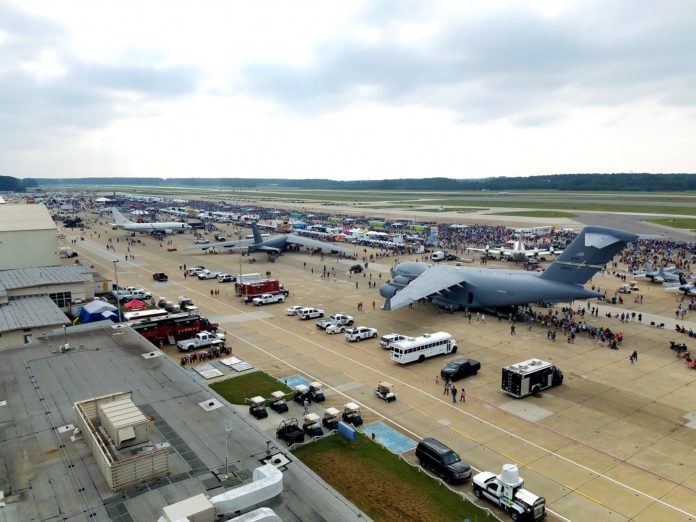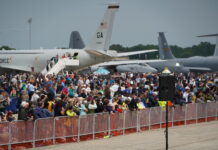The 2013 International Council of Air Shows (ICAS) Convention was another exceptional event hosted in Las Vegas in December. This annual event gives ICAS members the ability to discuss how to improve air shows and aerial events with reference to safety, logistics, entertainment, planning, and education. The mentoring from our senior air show members to those newer to this field has never been better.
We were fortunate to have Representative Sam Graves (R-MO) and retired U.S. Army colonel, Dr. Jeff McCausland, who discussed some of the effects of sequestration, and the “optics” piece of military aviation support in the eyes of Washington, D.C.
Yet, after all the events and education sessions were completed, we failed to walk away from the convention with a consolidated and deliberate effort by ICAS members on: “How Do We Ensure 2013 Never Happens Again?” It must be made a higher priority to engage elected officials and business leaders, who will — in return — force a policy change at the Office of Secretary of Defense (OSD) level with regard to the support of civilian air shows and the continuing allowance of military air shows.
Last year, sequestration — or in actuality — the rules that followed from OSD Public Affairs Division in March 2013, effectively shut down all military community relations events including ground/aerial demonstrations and even basic support to veterans’ affairs or local race support. As an example of how irrational the guidance became, local military units indigenous to San Diego were forced to develop a waiver to OSD’s direction to support the resident Veterans Village Stand Down in San Diego, California which had been supported by Marine units for over a decade. While this annual event costs less than $5,000 in set-up and fuel costs, it supports homeless veterans by supplying medical and mental health care, food and shelter, and the opportunity to interview for jobs.
The interaction with the homeless veterans and local leadership was an example of how current service members would give back to the community and be good neighbors. It allowed young Marines and sailors to do something positive with our primary audience: the public. It was only due to pressure from Congresswoman Susan Davis (D-CA), State Senator Joel Anderson, and leaders from both the Navy League and Veterans of Foreign Wars (VFW) that the OSD waiver was approved and the homeless veterans were able to receive this support.
From the guidance issued in March of 2013 to the most recent restrictions, waivers have been “welcomed” but mostly rejected with a message from OSD stating: “Therefore, I disapprove the (insert military service’s) request to support this event. I commend event organizers for seeking opportunities to showcase military aviation and encourage them to continue to seek new and creative means of doing so in the face of continuing Department fiscal constraints.”
The most recent guidance came from Secretary of Defense Chuck Hagel on September 30, 2013 (just prior to the federal government shutdown). This memorandum titled, “Department of Defense Fiscal Year 2014 Outreach Activities,” highlighted that sequestration restrictions, “…kept us [the US government] from connecting with nearly a half billion people worldwide,” even though many military flight dollars were already funded and flown during Fiscal Year (FY) 2013. This newest paper trumped the previous OSD instructions from the spring of 2013 (which cancelled all military support of community relations events) and allowed the military to engage in community relations events.
However, the number of events is much less than in the past decade and there is a much more stringent and hierarchal approval process. Thus, while OSD is allowing for the Blue Angels, Thunderbirds, the F-22 single-ship demo team, and approximately 16 Marine Corps AV-8B Harrier and MV-22 Osprey aerial demonstrations this calendar year, all other flyovers and the display of military aircraft at non-tenant fields or other military services’ air shows are not allowed.
While the World Series and San Diego Chargers received flyovers, these were rare occurrences and often directed from top down. Overall, since April 2013, over 2,600 community relations activities have been denied, and — out of those organizations that requested exceptions to the OSD policy — few have been approved.
If a military aircraft flies over a National Football League, collegiate football, Major League Baseball game, or if that same aircraft flies an aerial demonstration or to an air show to remain as a static display, the funding for that aircraft remains the same. Flight hours (gas, maintenance, etc.) are apportioned at the beginning of the year and all flights are able to be logged as Training and Readiness (T&R) codes to maintain proficiency in everything from aerial refueling, to formation flying, to small area confined landing, and much more. The hours for these aircraft, which are already funded, can be utilized to support community relations’ events just as easily as they are utilized for local training flights. Additionally, many squadrons do not conduct weekend training, and, therefore, the flights to and from air shows allow for additional allocated flight hours to be flown.
Per the current approved two-year budget deal, funds for Temporary Assigned Duty (TAD)/Temporary Duty (TDY) are available and should be utilized to allow for static displays at civilian airports as well as other United States military airfields. Again, for example: should a Marine Corps aircraft fly a cross county trip to Williams Gateway Airfield in Mesa, Arizona to remain overnight or to Luke Air Force Base to remain for a static display at that base’s air show, the same amount of flight hours will be utilized with training occurring during both periods. The ability to display a non-United States Air Force aircraft to Phoenix residents is an opportunity to inform the public of what military aviation assets are out there and show citizens how their federal taxes are being used.
Current guidelines also prohibit air shows and open houses from providing free room and board which would actually decrease the amount of federal money being used for TAD/TDY costs. This change of guidance is counterintuitive, as the DD-2535 form (request for military aerial/aviation support) notes that lodging costs should be incurred by air shows or event coordinators requesting support. The taxpayer paid for these aircraft and the pilot training; they should be able to see what they paid for, no matter where they reside.
Lastly, what happened to Marine Corps Air Station (MCAS) Miramar in 2013 should be highlighted as an extraordinary travesty. With the rules placed upon the Department of Defense and its subordinate units, in April of 2013, MCAS Miramar put forth a waiver package to continue to conduct its October, 2013 air show with military units and demonstrations. MCAS Miramar was the only military airfield to attempt such an open house last year with aerial and ground demonstrations. This effort was supported by Representative Duncan Hunter (R-CA), multiple elected officials within the Southern California region, the San Diego Chamber of Commerce, and the Veterans of Foreign Wars California Post Commander…to name a few. Eventually, the waiver was denied to utilize military demonstrations, but the open house could continue.
With the impending threat of a government shutdown in early October, the military leadership within Southern California readdressed how the air show could continue. Again, the legal and financial experts were able to agree that it was a thorough plan; the contracts had been signed, and, legally, there was no violation of orders by the Department of Defense. However, on Thursday, October 2, 2013 — the day before the event — with bleachers, tents and restrooms set up, and multiple aerial acts already in place, the show was turned off because of “optics.” The San Diego-based leadership ensured that they legally and financially followed all rules and restrictions placed on them by the highest elements of our government, but, in the end, it was canceled due to the perception — right or wrong – of an air show occurring during the actual government shutdown even while the money had already been spent utilizing Non-Appropriated Funding (at no cost to the government).
The cancellation of the Miramar show cost the federal government more than $600,000 and the local San Diego community millions more. This loss of money was unforgivable, as the generated funds go into multiple family, welfare, and counseling programs which help amplify and improve existing programs.
Thus, we finally come to the question which must be posed: “Will this or can this occur again?”
With constant debates in Washington D.C. on the debt ceiling, as well as future budget battles, and the Department of Defense still looking to cut costs, the answer is surely “Yes.” Thus, we, and that means all aviation enthusiasts and supporters, must help prevent a repeat of the 2013 season – by:
1. Developing and strengthening Political Action Committees within the EAA, ICAS, AOPA, and other aviation groups to reach out to Congress to take action within the Department of Defense. The VFW was instrumental in trying to help the Miramar Air Show last year, but still to no avail as the show was finally cancelled during the government shutdown.
2. Getting word to all ICAS civilian members to contact their local elected officials and chambers of commerce to force the OSD to change its rules. Generally, it is looked upon with scorn when currently serving members of the armed forces reach out to elected officials. However, there are multiple parties in aviation (AOPA, EAA); veterans’ affairs (VFW, American Legion); and civilian affairs (Rotary International), that have influence; and these are but a few of the examples of national and international groups. Many local leaders of groups supporting collegiate athletics shied away from asking for elected officials’ support even though military units were willing to conduct flyovers. While many of these desired the interaction with military aerial and aviation acts, they were afraid to speak up.
3. Educating all air show personnel — both military service members and civilians — on how to submit a change to the current September 30, 2013 OSD guidance. Changing the current guidance could allow for military static aircraft at civilian air shows as well as the ability to “cross-pollinate” other services’ airplanes at air shows in which the public does not often see those aircraft. Thousands of requests have been submitted and denied, but there is something to be said for inundating this office with waivers until they capitulate to allow for more demonstrations and the easing of static display rules. Multiple air show personnel, from military services that control these air shows and open houses, desire for this guidance to change, but admit that some of their leaders in D.C. are not supportive of such efforts. This is disappointing, as it demonstrates that those officials are too far removed from the necessities to support such energies at the local and regional levels.
These events not only support the families and friends of the military by demonstrating their skills and educating them on the benefits of aviation, they also form strong and important relations outside of those installations. The impact of these events is felt regionally, nationally, and even internationally. Military bases are seen not just as a source of jobs, but as an integral and important part of the communities in which the bases are located. The consistent and persistent interaction with each community gives the media and the public (including key members within the local business communities) the advantage of the military’s professional credibility should an incident ever occur.
Finally, while it was not overtly broadcast, members of ICAS would, in private, acknowledge the true reasons for which we were in the current situation: i.e. the cancellation of White House tours, closing of open air national parks which required no manning, ceasing of military aviation support, etc. The truth was that the cessation of military aerial support was not about money; it was about the “optics” or “perception” of the federal government. It is necessary to engage those within the Beltway, who make decisions on these local, regional, and international events, since they reside in the affected areas.
The attack (and it should be looked upon as such) against air shows and general aviation, stifles our ability to inform future generations about aviation and fill them with the same love of aviation with which we all have been blessed. It will take a concerted effort by our aviation family to make such changes and I hope we can champion that support.








